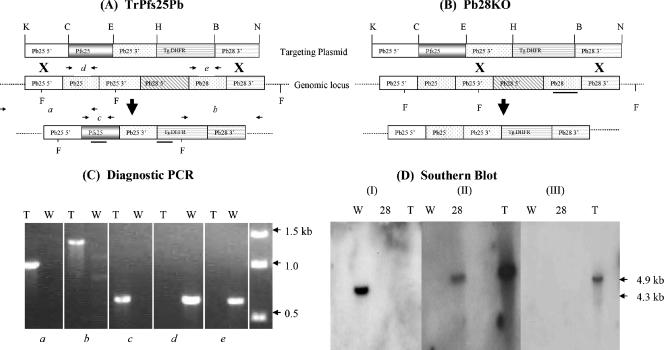FIG. 1.
DNA plasmid constructs, PCR, and Southern blot analysis. (A) Schematic representation (not drawn to scale) of the targeting DNA vector plasmid used for transfection and the resultant locus after vector integration. The vector construct contained a drug-selectable marker (Tg.DHFR), 5′ and 3′ UTR sequences of pb25, pfs25 (full-length coding sequence), and 3′ UTR of pb28 (ligated through introduced restriction sites [K, KpnI; C, ClaI; E, EcoRI; H, HindIII; B, BamHI; N, NotI]) for targeted integration. Two homologous recombination events (indicated by the X) occurred, generating pb25/28 knockout parasites designated TrPfs25Pb (A) and Pb28KO (B) parasites. The regions to which the different probes hybridized are indicated by bold horizontal lines in panels A and B. (C) PCR analysis of genomic DNA to confirm correct integration of the vector construct into the transgenic (T) parasite's genome. The primer pairs used in gels a to e are identified in the legend for panel A, and DNA from wild-type (W) P. berghei parasites was used as a control. (D) Southern analysis of FokI (F)-digested genomic DNA from wild-type (W), Pb28KO (28), and TrPfs25Pb (T) to confirm proper integration of the targeting plasmid in the genomic DNA and to rule out the possible presence of untransformed wild-type DNA or episomal plasmid DNA. The pb28 probe hybridized to a 4.3-kb fragment in the W parasites (I), the dhfr probe hybridized to a 4.9-kb fragment in the DHFR backbone (II) in 28 and T parasites, and the pfs25 probe hybridized to a 4.9-kb fragment in T parasites (III).

